Abstract
1. In order to shed more light on the role of presynaptic cholinoceptors in the modulation of transmitter release, the effects of tubocurarine, choline and hexamethonium on neostigmine-induced tetanic fade and run-down of endplate potentials (e.p.ps) in response to indirect stimulation with trains of pulses were studied in the intact and cut isolated phrenic nerve-diaphragm preparation of the mouse, respectively. 2. Tubocurarine, choline and hexamethonium reduced both the tetanic fade and e.p.p. run-down caused by neostigmine, despite the fact that they themselves also induced these two effects. 3. At a given degree of postsynaptic inhibition, choline and hexamethonium caused less e.p.p. run-down and reversed the neostigmine-induced tetanic fade and e.p.p. run-down better than tubocurarine. Moreover, the e.p.p. run-down caused by choline or hexamethonium, but not that induced by tubocurarine, was reciprocally reversed by neostigmine. 4. Tubocurarine, choline and hexamethonium significantly decreased the endplate depolarization induced by repetitive nerve stimulation in the presence of neostigmine. The remaining depolarization continued to grow during repetitive stimulation in the presence of choline or hexamethonium, but not, however, in the presence of tubocurarine; a finding which suggests that choline and hexamethonium but not tubocurarine may be displaced from the receptor by the accumulated acetylcholine. 5. The mutual reversal by neostigmine and cholinoceptor antagonists of e.p.p. run-down may implicate the presence of a positive (physiological) and a negative (pharmacological) feedback regulation for evoked transmitter release via nicotinic cholinoceptors in the mammalian motor nerve, depending on the concentration of acetylcholine within the synaptic cleft.
Full text
PDF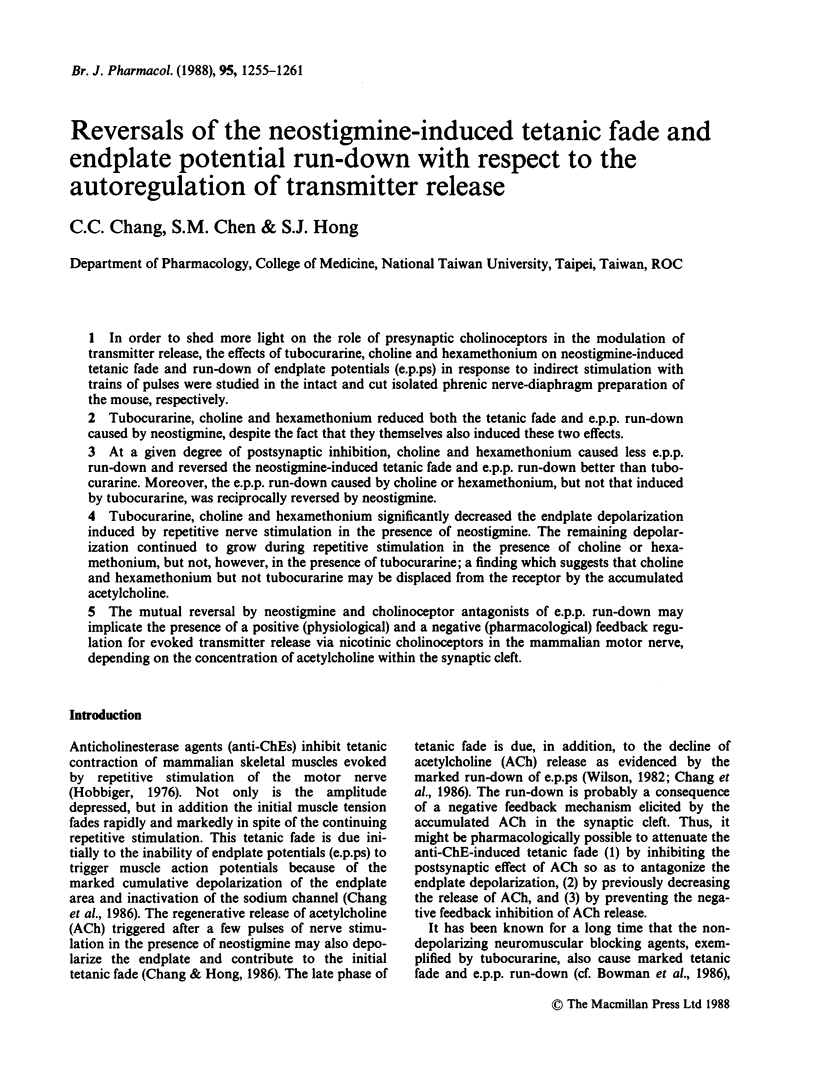
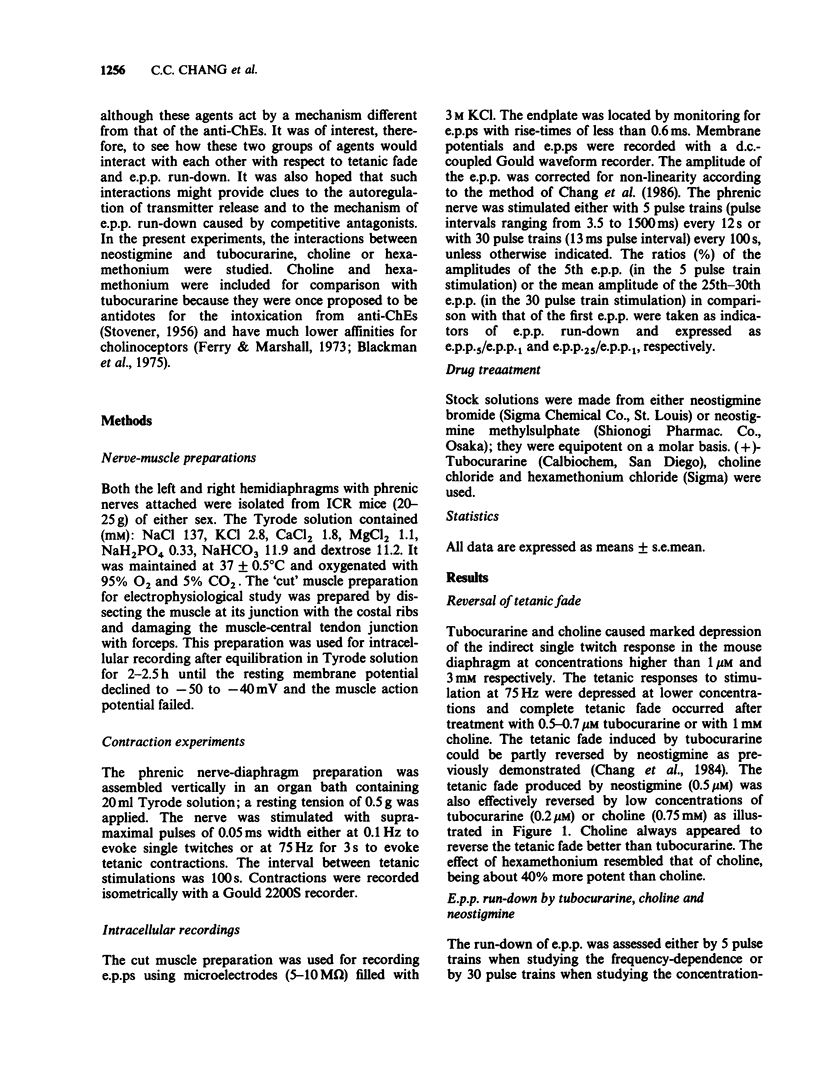
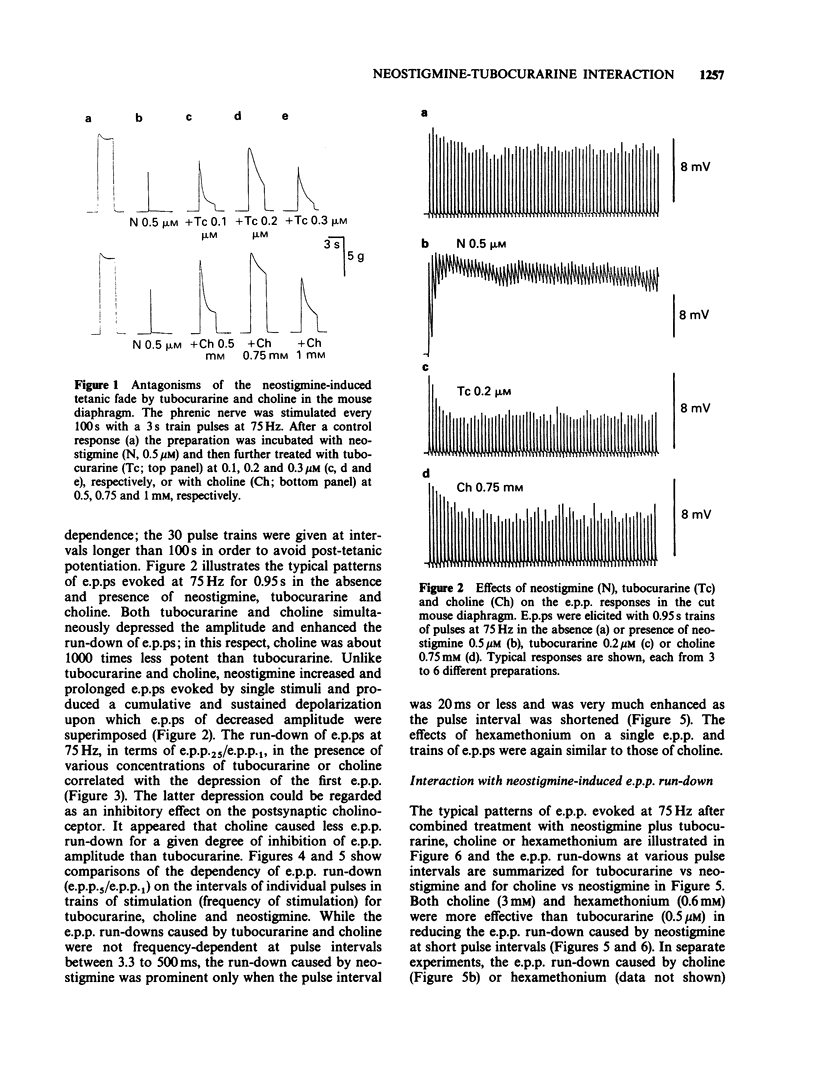
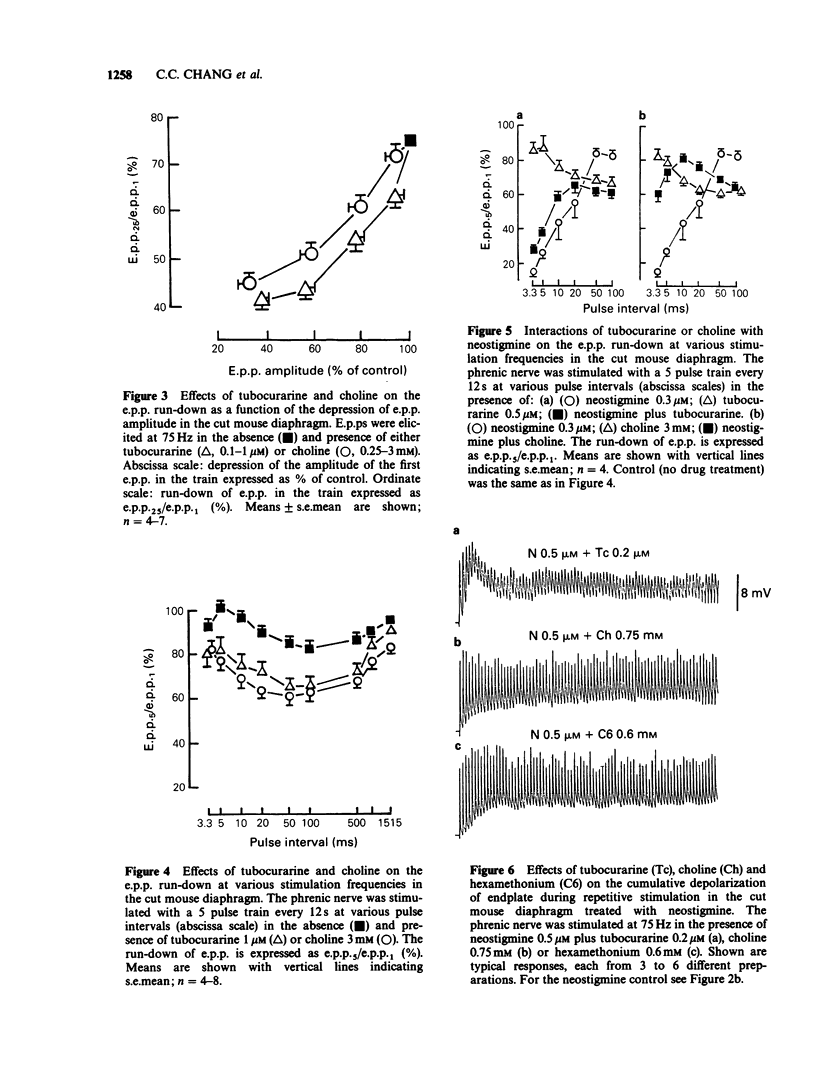
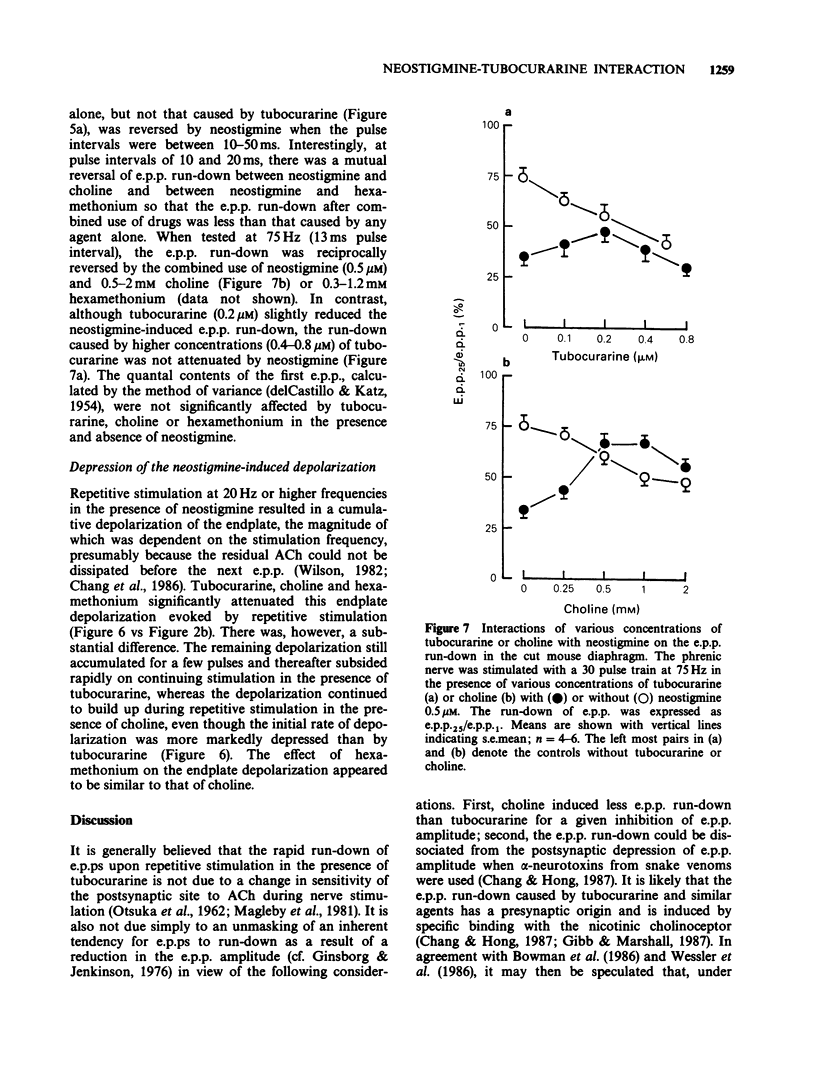
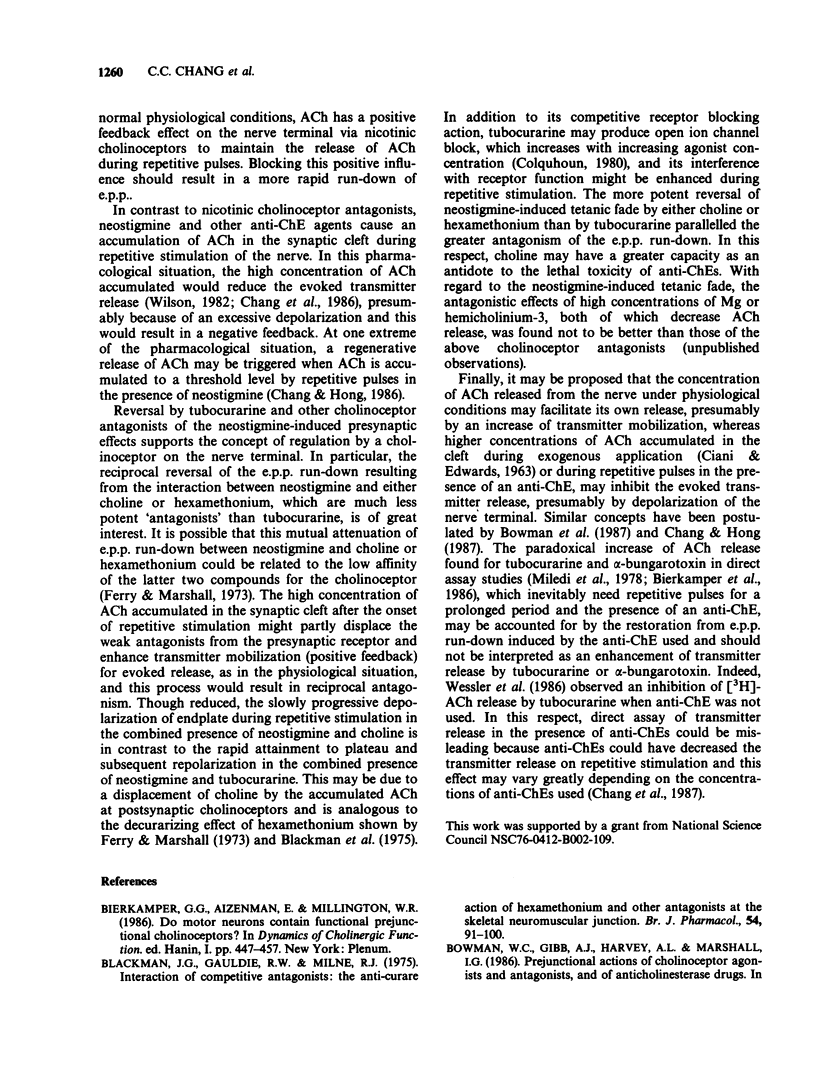
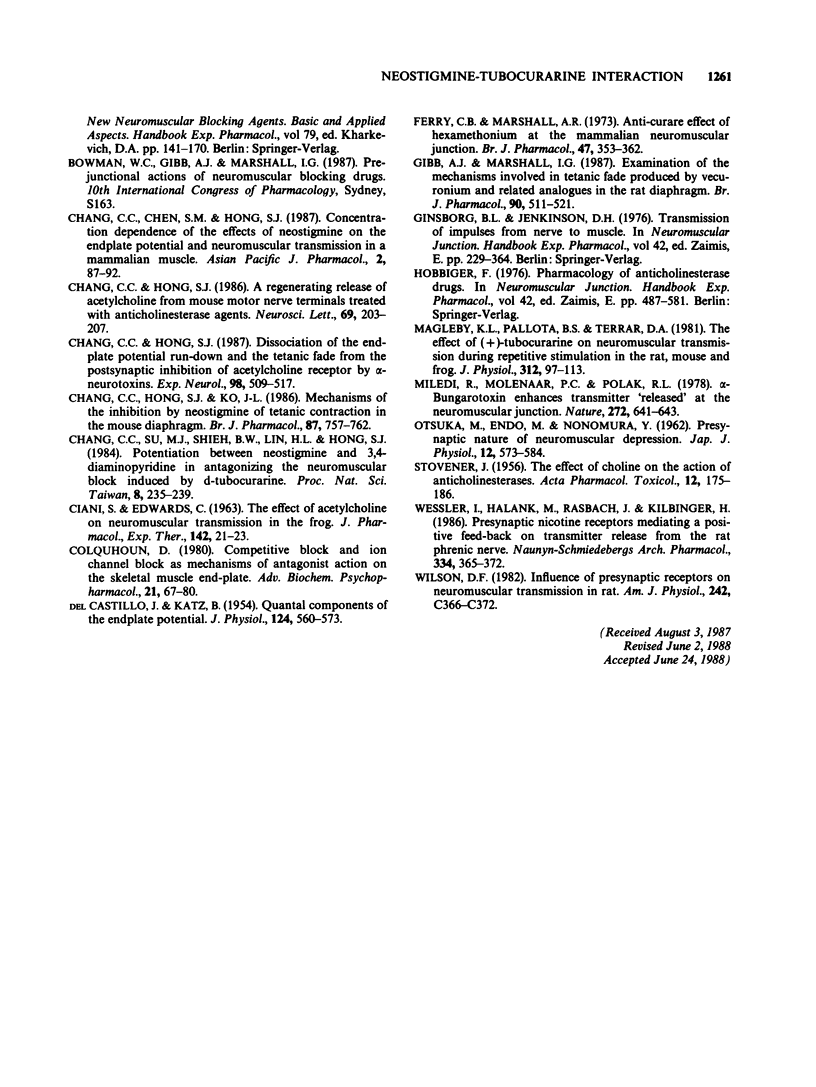
Selected References
These references are in PubMed. This may not be the complete list of references from this article.
- Blackman J. G., Gauldie R. W., Milne R. J. Interaction of competitive antagonists: the anti-curare action of hexamethonium and other antagonists at the skeletal neuromuscular junction. Br J Pharmacol. 1975 May;54(1):91–100. doi: 10.1111/j.1476-5381.1975.tb07414.x. [DOI] [PMC free article] [PubMed] [Google Scholar]
- CIANI S., EDWARDS C. THE EFFECT OF ACETYLCHOLINE ON NEUROMUSCULAR TRANSMISSION IN THE FROG. J Pharmacol Exp Ther. 1963 Oct;142:21–23. [PubMed] [Google Scholar]
- Chang C. C., Hong S. J. A regenerating release of acetylcholine from mouse motor nerve terminals treated with anticholinesterase agents. Neurosci Lett. 1986 Aug 29;69(2):203–207. doi: 10.1016/0304-3940(86)90604-x. [DOI] [PubMed] [Google Scholar]
- Chang C. C., Hong S. J. Dissociation of the end-plate potential run-down and the tetanic fade from the postsynaptic inhibition of acetylcholine receptor by alpha-neurotoxins. Exp Neurol. 1987 Dec;98(3):509–517. doi: 10.1016/0014-4886(87)90260-3. [DOI] [PubMed] [Google Scholar]
- Chang C. C., Hong S. J., Ko J. L. Mechanisms of the inhibition by neostigmine of tetanic contraction in the mouse diaphragm. Br J Pharmacol. 1986 Apr;87(4):757–762. doi: 10.1111/j.1476-5381.1986.tb14594.x. [DOI] [PMC free article] [PubMed] [Google Scholar]
- Chang C. C., Su M. J., Shieh B. H., Lin H. L., Hong S. J. Potentiation between neostigmine and 3,4-diaminopyridine in antagonizing the neuromuscular block induced by D-tubocurarine. Proc Natl Sci Counc Repub China B. 1984 Jul;8(3):235–239. [PubMed] [Google Scholar]
- Colquhoun D. Competitive block and ion channel block as mechanisms of antagonist action on the skeletal muscle end-plate. Adv Biochem Psychopharmacol. 1980;21:67–80. [PubMed] [Google Scholar]
- DEL CASTILLO J., KATZ B. Quantal components of the end-plate potential. J Physiol. 1954 Jun 28;124(3):560–573. doi: 10.1113/jphysiol.1954.sp005129. [DOI] [PMC free article] [PubMed] [Google Scholar]
- Ferry C. B., Marshall A. R. An anti-curare effect of hexamethonium at the mammalian neuromuscular junction. Br J Pharmacol. 1973 Feb;47(2):353–362. doi: 10.1111/j.1476-5381.1973.tb08333.x. [DOI] [PMC free article] [PubMed] [Google Scholar]
- Gibb A. J., Marshall I. G. Examination of the mechanisms involved in tetanic fade produced by vecuronium and related analogues in the rat diaphragm. Br J Pharmacol. 1987 Mar;90(3):511–521. doi: 10.1111/j.1476-5381.1987.tb11200.x. [DOI] [PMC free article] [PubMed] [Google Scholar]
- Magleby K. L., Pallotta B. S., Terrar D. A. The effect of (+)-tubocurarine on neuromuscular transmission during repetitive stimulation in the rat, mouse, and frog. J Physiol. 1981 Mar;312:97–113. doi: 10.1113/jphysiol.1981.sp013618. [DOI] [PMC free article] [PubMed] [Google Scholar]
- Miledi R., Molenaar P. C., Polak R. L. Alpha-Bungarotoxin enhances transmitter "released" at the neuromuscular junction. Nature. 1978 Apr 13;272(5654):641–643. doi: 10.1038/272641a0. [DOI] [PubMed] [Google Scholar]
- OTSUKA M., ENDO M., NONOMURA Y. Presynaptic nature of neuromuscular depression. Jpn J Physiol. 1962 Dec 15;12:573–584. doi: 10.2170/jjphysiol.12.573. [DOI] [PubMed] [Google Scholar]
- Wessler I., Halank M., Rasbach J., Kilbinger H. Presynaptic nicotine receptors mediating a positive feed-back on transmitter release from the rat phrenic nerve. Naunyn Schmiedebergs Arch Pharmacol. 1986 Dec;334(4):365–372. doi: 10.1007/BF00569371. [DOI] [PubMed] [Google Scholar]
- Wilson D. F. Influence of presynaptic receptors on neuromuscular transmission in rat. Am J Physiol. 1982 May;242(5):C366–C372. doi: 10.1152/ajpcell.1982.242.5.C366. [DOI] [PubMed] [Google Scholar]


